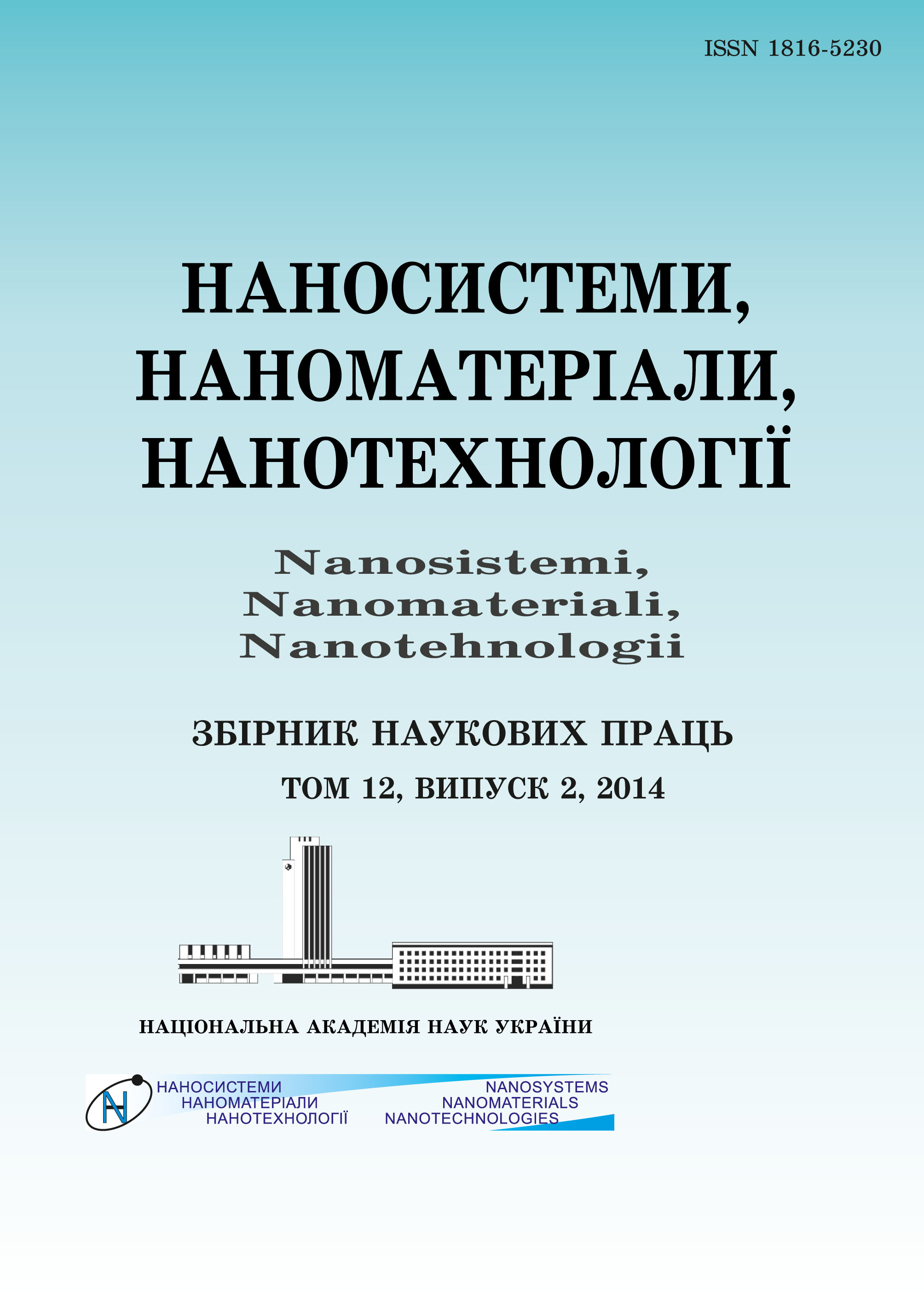|
|
|||||||||

|
Year 2025 Volume 23, Issue 2 |
|
|||||||
|
|||||||||
Issues/2025/vol. 23 /issue 2 |
|
V. R. HAIEVSKYI1, V. Z. KOCHMARSKYI1, B. D. NECHYPORUK2, S. H. HAIEVSKA3, and O. V. HARASHCHENKO1
1National University of Water and Environmental Engineering, 11 Soborna Str., UA-33028 Rivne, Ukraine
2Rivne State University of Humanities, 12 Stepan Bandera Str., UA-33028 Rivne, Ukraine
3Rivne Scientific Research Forensic Center of the Ministry of Internal Affairs of Ukraine, 39 Vasyl Chervonii Str., UA-33003 Rivne, Ukraine
The Effect of a Magnetic Field on the Formation of Nanosize Crystallites During the Crystallization of Calcium Carbonate from Bicarbonate Solutions
393–405 (2025)
PACS numbers: 61.66.Fn, 61.68.+n, 64.70.dg, 81.10.Dn, 82.45.Gj, 82.45.Yz, 83.60.Np
The formation of nanosize crystallites during the crystallization of calcium carbonate from aqueous bicarbonate solutions under the influence of a permanent magnetic field is studied. Crystallization took place in aqueous hydrocarbon solutions by mixing aqueous solutions of CaCl2 and NaHCO3. The concentrations of the initial components of the studied system are calculated on the basis of the thermodynamic constants of the first- and second-order dissociations of carbonic acid, the concentration constants of stability of the NaCO3− and NaHCO30 complexes, the electroneutrality equation and the mass-balance equation, as well as the experimental measurement of the activity index of hydrogen ions. To calculate the ionic strength of the solution according to the Debye–Hückel theory, the method of iterations is used, in which the initial model concentrations are taken for the first iteration. As a result of the calculations, it is established that the main component of the carbonate subsystem under these conditions is HСО3−, the ratio of concentrations of hydrocarbonate ions to carbonate ions exceeds 18, and therefore, the process of crystallization of calcium carbonate occurs through the intermediate reaction of dissociation of hydrocarbonate ions that is a feature of the investigated process. XRD studies show that under the given conditions of the experiment, two modifications of calcium carbonate are formed: calcite and vaterite; but aragonite is unlikely to be formed. Calculation of crystallite sizes using the Debye–Scherrer method shows that, as a result of synthesis, nanocrystals are formed, the sizes of which are of 110 nm for calcite and of 23 nm for vaterite. As established, under the given conditions of synthesis, the magnetic field with an induction of 125–250 mT practically does not affect the sizes of the calcite and vaterite nanocrystals.
KEY WORDS: magnetic treatment, crystallization of calcium carbonate, carbonate aqueous system, electrolyte solutions, Debye–Hückel theory, iteration method, XRD analysis, Debye–Scherrer method
DOI: https://doi.org/10.15407/nnn.23.02.0393
REFERENCES
- T. Vermeiren, Anti-Corrosion Methods and Materials, 5, No. 7: 215 (1958); https://doi.org/10.1108/eb019464
- V. Z. Kochmarskii, V. R. Gayevskii, O. V. Kochmarskii, and S. G. Nechyporuk, Visnyk NUWEE, 2, No. 46: 234 (2009) (in Ukraine).
- V. R. Gayevskii, B. D. Nechyporuk, and S. G. Gayevska, Physics and Chemistry of Solid State, 24, No. 4: 616 (2023); https://doi.org/10.15330/pcss.24.4.616-622
- V. R. Gayevskii, V. Z. Kochmarskii, and S. G. Gayevska, Journal of Crystal Growth, 548: 125844 (2020); https://doi.org/10.1016/j.jcrysgro.2020.125844
- CRC Handbook of Chemistry and Physics. 90th Edition (CD-ROM Version 2010) (Ed. D. R. Lide) (Boca Raton, FL: CRC Press–Taylor and Francis: 2010).
- V. R. Gajevskiy, Ukrainian Journal of Physics, 60: 258 (2015); https://doi.org/10.15407/ujpe60.03.0258
- V. R. Gayevskii and V. Z. Kochmarskii, Pidvyshchennya Ehfektyvnosti Oborotnykh System Okholodzhennya Minimizatsiyeyu Kaltsiy-Karbonatnykh Vidkladen' [Increasing the Efficiency of Reversible Cooling Systems by Minimizing Calcium Carbonate Deposits] (Rivne: NUWEE: 2018) (in Ukrainian); http://ep3.nuwm.edu.ua/id/eprint/15612
- V. R. Gayevskii, V. L. Fylypchuk, and O. U. Deyneka, Ukrainian Journal of Construction and Architecture, No. 5 (011): 27 (2022) (in Ukrainian); https://doi.org
- V. Z. Kochmarskii, V. R. Gayevskii, and N. L. Tyshko, Ukrainian Journal of Physics, 62, No. 5: 382 (2017); https://doi.org/10.15407/ujpe62.05.0382
- V. R. Gayevskii, V. Z. Kochmarskii, and S. H. Gayevska, Ukrainian Journal of Physics, 66, No. 8: 708 (2021); https://doi.org/10.15407/ujpe66.8.708
- H. S. Harned and B. B. Owen, The Physical Chemistry of Electrolytic Solutions (New York: Reinhold: 1967).
- D. G. Peters, J. M. Hayes, and G. M. Hieftje, Chemical Separations and Measurements. Theory and Practice of Analytical Chemistry (W. B. Saunders Co.: 1974).
- Ye. O. Mykhailova, M. O. Moroz, and O. L. Sincheskul, Herald NTU 'KhPI'. Series: Chemistry, Chemical Technology and Ecology, No. 48 (1269): 68 (2017) (in Ukrainian).
- L. Y. Mirkin, Spravochnik po Rentgenostrukturnomu Analizu Polikristallov [Handbook of X-Ray Diffraction Analysis of Polycrystals] (Ed. Ya. S. Umanskiy) (Moskva: 1961) (in Russian).
- V. Y. Lysoivan, Izmerenie Parametrov Ehlementarnoy Yacheiki na Odnokristal'nom Spektrometre [Measurement of Unit Cell Parameters on a Single-Crystal Spectrometer] (Novosibirsk: Nauka, Sib. Otd.: 1982) (in Russia).
- A. Achour, A. Arman, M. Islam, A. A. Zavarian, A. Basim Al-Zubaidi, and J. Szade, Eur. Phys. J. Plus, 132: 267 (2017); https://doi.org/10.1140/epjp/i2017-11531-8
- Gen-Tao Zhou, Jimmy C. Yu, Xin-Chen Wang, and Li-Zhi Zhang, New. J. Chem., 28: 1027 (2004); https://doi.org/10.1039/B315198K
- Mehrdad Khatami, Hajar Q. Alijani, Nooshin Hashemi, Zahra Mahmoudi, Samaneh Darijani, Mehdi Bamorovat, Alireza Keyhani, Meghdad Abdollahpour-Alitappeh, and Fariba Borhani, Royal Society of Chemistry Advances, 10, Iss. 62: 38063 (2020); https://doi.org/10.1039/D0RA04503A
- V. R. Gaevs'kyi, B. D. Nechyporuk, N. Yu. Novoselets'kyi, and B. P. Rudyk, Ukrainian Journal of Physics, 58, No. 4: 385 (2013); https://doi.org/10.15407/ujpe58.04.0385
- N. B. Danilevska, M. V. Moroz, M. Yu. Novoseletskyi, B. D. Nechyporuk, and B. P. Rudyk, Journal of Physical Studies, 20, No. 3: Article 3601 (2016); https://doi.org/10.30970/jps.20.3601
 This article is licensed under the Creative Commons Attribution-NoDerivatives 4.0 International License ©2003 NANOSISTEMI, NANOMATERIALI, NANOTEHNOLOGII G. V. Kurdyumov Institute for Metal Physics of the National Academy of Sciences of Ukraine. E-mail: tatar@imp.kiev.ua Phones and address of the editorial office About the collection User agreement |